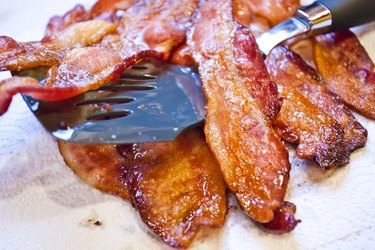
Unless you live in the South, you may not be able to find pork jowl bacon at your local grocery store. However, if you happen to find this flavorful cut of meat, you can prepare it much like you would your usual bacon.
Tip
You can prepare your pork jowl bacon the same way you cook your usual bacon, which includes the stove, oven or microwave.
Video of the Day
What Is Pork Jowl Bacon?
According to the USDA, bacon typically means cured pork belly. However, bacon can come from other parts of the pig, including the jowls, which you may know better as the cheeks.
Video of the Day
Pork jowl may be available fresh. But like traditional bacon, pork jowl bacon needs to undergo a curing and smoking process in order to be called bacon. After the meat has been skinned and trimmed, the pork jowls are cured with salt and nitrites. Then the meat is heat processed and smoked to add flavor.
Like regular bacon, jowl bacon is high in calories and fat and not a very good source of protein. A 0.5 ounce serving of pork jowl bacon has 100 calories, 1 gram of protein, 10 grams of total fat, 3 grams of saturated fat and 125 milligrams of sodium. Because bacon contains more fat than protein, the National Institutes of Health classifies bacon as a fat on their food exchange list.
Read more: Are Bacon & Eggs a Healthy Breakfast?
Cooking Jowl Bacon
You can prepare jowl bacon on the stove or in the oven or microwave. While bacon is traditionally prepared on the stove, you may find that it cooks more evenly in the oven. Cooking jowl meat in the oven may take a little longer than on the stove.
If it's not already sliced, first slice the hog jowl into the desired thickness for bacon. When preparing it on the stove, preheat your griddle pan over medium heat to 300 to 350 degrees Fahrenheit. Place the slices of pork jowl bacon in your pan, being sure not to overcrowd it. Cook it for about 10 to 15 minutes, turning the jowl meat frequently to prevent burning.
For oven cooking the jowl bacon, bake in a preheated 350 F oven. According to the USDA, the length of time needed to bake your jowl bacon in the oven may depend on the thickness of the savory meat, but you should cook it until crispy.
For crispy jowl bacon in the microwave, Purdue University recommends cooking the bacon in between sheets of microwave-safe paper towels on a microwave-safe plate for 4 to 6 minutes.
Tip
Unlike other types of meat, the USDA says it’s too difficult to get an accurate cooking temperature for bacon to determine doneness with a meat thermometer. As long as you cook your pork jowl bacon until it's crispy, the meat is considered safe.
However, the USDA warns against partially cooking bacon as it may increase the risk of foodborne illness. You should always fully cook bacon before removing it from your heat source, and it can be stored in the refrigerator for up to 7 days. Use any of your leftover pork jowl bacon for bacon and egg salad or Cobb salad to add flavor.
Bacon and Your Health
No matter what part of the pig your bacon comes from, it's still a processed meat and not the type of food you should be eating on a regular basis. According to the Harvard T.H. Chan School of Public Health, eating too many processed meats like bacon may increase your risk of heart disease, Type 2 diabetes and certain types of cancer.
The American Institute for Cancer Research (AICR) suggests that regular consumption of processed meat increases risk of colon cancer. The increased risk may be due to a number of factors in the processed meat, according to AICR, and they suggest you avoid these types of meats altogether.
Pork jowl bacon is also high in saturated fat and sodium. For heart health, the American Heart Association recommends keeping saturated fat intake to no more than 6 percent of your daily calorie intake (13 grams on a 2,000-calorie diet) and holding your sodium intake to 2,300 milligrams or less.
- USDA: "Bacon and Food Safety"
- USDA FoodData Central: "Frick's, Pork Jowl Bacon, Hickory Smoked"
- National Institutes of Health: National Heart, Lung and Blood Institute: "Food Exchange Lists"
- Purdue University: "Microwave Cooking Meat"
- Harvard T.H. Chan School of Public Health: "New 'Guidelines' Say Continue Red Meat Consumption Habits, but Recommendations Contradict Evidence"
- American Institute for Cancer Research: "Red and Processed Meats"
- American Heart Association: "Saturated Fat"
- American Heart Association: "How Much Sodium Should I Eat Per Day?"
- The Southern Table: Fat Back and Hog Jowls